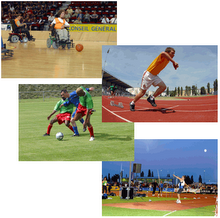
Anaerobic threshold (AT) is a frequently used term that sometimes causes a little confusion. What is the AT and how can you use it to run faster? For starters, the AT is an extremely reliable and powerful predictor of performance in aerobic exercise. To explore further, I will begin with a brief, oversimplified, review of physiology. Muscles can "burn" glucose two ways, aerobically ("with oxygen") and anaerobically ("without oxygen"). Both systems generate a temporary energy store, called ATP, which in turn produces mechanical work. However, there are some major differences.
An all out sprint, which requires a great deal of power output in a short period of time, uses the anaerobic system. The energy is quickly available, but the anaerobic pathways are not very efficient ; short term energy stores are rapidly depleted, lactic acid builds up, and exercise soon comes to a halt. After a brief rest, the system is recharged and ready for the next sprint. Distance running, which requires a steady power output over a long period of time, uses the aerobic system. These pathways can't generate the speed of the anaerobic, but they do possess a great deal more efficiency and endurance. Depending upon the distance, and effort, the body can use different proportions of both of these systems. Those who have raced the 800 meter know it's too long to be a sprint, but too short to be distance. This is right at the cross-over between the aerobic and anaerobic systems.
While running at a comfortable pace you use both systems, but the anaerobic:aerobic ratio is low enough that the lactate generated is easily removed, and doesn't build up. As the pace is increased, eventually a point is reached where the production of lactate, by the anaerobic system, is greater than its removal. The AT, also known as the lactate threshold, is the point where lactate (lactic acid) begins to accumulate in the bloodstream.
The AT varies from person to person, and, within a given individual, sport to sport. Untrained individuals have a low AT (approximately 55 % of VO2 max), and elite endurance athletes, a high AT (approx. 80 - 90% of VO2 max). You can train your body to remove lactate better and to juice up the aerobic mitochondrial enzymes, thus raising the AT. Don't worry you still get to experience the joy of lactate-laden legs that won't move, but it will happen at a faster running speed. Applying the right types of workouts is the key to properly shape your AT.
Interval work consists of a repeated series of short, high intensity, runs alternating with rest periods. Regardless of the race distance you are training for, 5k or marathon, interval work will help you run faster. Intervals should be creative, fun, and definitely not done every day. Whether it's 10 x 800m, or a 200m, 400m, 800m 400m, 200m pyramid, continually pushing yourself into a lactate burdened state makes your body adapt. Your aerobic enzymes get supercharged, and you become better at processing lactate.
So how do you know if your workouts are pushing your AT? After several track workouts, you'll notice the feeling when in the anaerobic zone. There are also exercise tests which can estimate your AT (e.g. Conconi test), and now, through the miracle of modern medical technology, a hand-held device for directly measuring lactate. A small pinprick, one drop of blood, and in less than a minute you know the exact blood lactate concentration. The corresponding heart rate at the AT gives you a convenient way of monitoring your workouts. Regardless, always pay attention to how running feels. Repeat testing several months later can show you how your training is shaping your physiology, and can help fine tune your training plan.
An all out sprint, which requires a great deal of power output in a short period of time, uses the anaerobic system. The energy is quickly available, but the anaerobic pathways are not very efficient ; short term energy stores are rapidly depleted, lactic acid builds up, and exercise soon comes to a halt. After a brief rest, the system is recharged and ready for the next sprint. Distance running, which requires a steady power output over a long period of time, uses the aerobic system. These pathways can't generate the speed of the anaerobic, but they do possess a great deal more efficiency and endurance. Depending upon the distance, and effort, the body can use different proportions of both of these systems. Those who have raced the 800 meter know it's too long to be a sprint, but too short to be distance. This is right at the cross-over between the aerobic and anaerobic systems.
While running at a comfortable pace you use both systems, but the anaerobic:aerobic ratio is low enough that the lactate generated is easily removed, and doesn't build up. As the pace is increased, eventually a point is reached where the production of lactate, by the anaerobic system, is greater than its removal. The AT, also known as the lactate threshold, is the point where lactate (lactic acid) begins to accumulate in the bloodstream.
The AT varies from person to person, and, within a given individual, sport to sport. Untrained individuals have a low AT (approximately 55 % of VO2 max), and elite endurance athletes, a high AT (approx. 80 - 90% of VO2 max). You can train your body to remove lactate better and to juice up the aerobic mitochondrial enzymes, thus raising the AT. Don't worry you still get to experience the joy of lactate-laden legs that won't move, but it will happen at a faster running speed. Applying the right types of workouts is the key to properly shape your AT.
Interval work consists of a repeated series of short, high intensity, runs alternating with rest periods. Regardless of the race distance you are training for, 5k or marathon, interval work will help you run faster. Intervals should be creative, fun, and definitely not done every day. Whether it's 10 x 800m, or a 200m, 400m, 800m 400m, 200m pyramid, continually pushing yourself into a lactate burdened state makes your body adapt. Your aerobic enzymes get supercharged, and you become better at processing lactate.
So how do you know if your workouts are pushing your AT? After several track workouts, you'll notice the feeling when in the anaerobic zone. There are also exercise tests which can estimate your AT (e.g. Conconi test), and now, through the miracle of modern medical technology, a hand-held device for directly measuring lactate. A small pinprick, one drop of blood, and in less than a minute you know the exact blood lactate concentration. The corresponding heart rate at the AT gives you a convenient way of monitoring your workouts. Regardless, always pay attention to how running feels. Repeat testing several months later can show you how your training is shaping your physiology, and can help fine tune your training plan.

















Hiç yorum yok:
Yorum Gönder